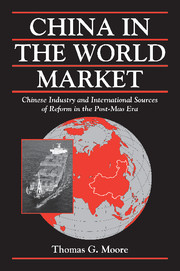Book contents
- Frontmatter
- Contents
- List of Figures
- List of Abbreviations
- Preface
- 1 China as a Latecomer in World Industrial Markets
- 2 The Outside World as an Impetus for Change in China
- 3 Tailor to the World: China's Emergence as a Global Power in Textiles
- 4 Beating the System with Industrial Restructuring: China's Response to the Multifiber Arrangement (MFA)
- 5 China Looms Large: Reform and Rationalization in the Textile Industry
- 6 Industrial Change in the Shadow of the MFA: The Role of Top-Level Strategy, Mid-Level Intervention, and Low-Level Demand in China's Textile Industry
- 7 Chinese Shipbuilding: The Modest Origins of an Emerging Industrial Giant
- 8 Dangerous Currents: Navigating Boom and Bust Cycles in International Shipbuilding
- 9 Chinese Shipbuilding and Global Surplus Capacity: Making a Virtue out of Necessity
- 10 Market-Oriented Solutions for Industrial Adjustment: The Changing Pattern of State Intervention in Chinese Shipbuilding
- 11 Who Did What to Whom?: Making Sense of the Reform Process in China's Shipbuilding Industry
- 12 External Shocks, State Capacity, and National Responses for Economic Adjustment: Explaining Industrial Change in China
- 13 China in the Contemporary International Political Economy
- Appendix Contours of the Research Effort
- Bibliography
- Index
8 - Dangerous Currents: Navigating Boom and Bust Cycles in International Shipbuilding
Published online by Cambridge University Press: 07 August 2009
- Frontmatter
- Contents
- List of Figures
- List of Abbreviations
- Preface
- 1 China as a Latecomer in World Industrial Markets
- 2 The Outside World as an Impetus for Change in China
- 3 Tailor to the World: China's Emergence as a Global Power in Textiles
- 4 Beating the System with Industrial Restructuring: China's Response to the Multifiber Arrangement (MFA)
- 5 China Looms Large: Reform and Rationalization in the Textile Industry
- 6 Industrial Change in the Shadow of the MFA: The Role of Top-Level Strategy, Mid-Level Intervention, and Low-Level Demand in China's Textile Industry
- 7 Chinese Shipbuilding: The Modest Origins of an Emerging Industrial Giant
- 8 Dangerous Currents: Navigating Boom and Bust Cycles in International Shipbuilding
- 9 Chinese Shipbuilding and Global Surplus Capacity: Making a Virtue out of Necessity
- 10 Market-Oriented Solutions for Industrial Adjustment: The Changing Pattern of State Intervention in Chinese Shipbuilding
- 11 Who Did What to Whom?: Making Sense of the Reform Process in China's Shipbuilding Industry
- 12 External Shocks, State Capacity, and National Responses for Economic Adjustment: Explaining Industrial Change in China
- 13 China in the Contemporary International Political Economy
- Appendix Contours of the Research Effort
- Bibliography
- Index
Summary
ONE of the most striking maritime developments in China during the 1980s was the substantially increased dependence on imported ships in expanding the country's merchant fleet (Figure 8.1). Given China's ability to build basic ships in series by the end of the 1970s, shipbuilding officials and foreign maritime observers had expected that Chinese yards would find themselves concentrating on the growing needs of the domestic merchant fleet. Given the tremendous expense of new ships (while falling, prices ranged from U.S. $20–100 million at the time, depending on the size and type of ship), it was doubly surprising that China began to rely increasingly on the purchase of new, rather than second-hand, ships in the world market (Figure 8.2).
Why did COSCO place orders overseas for ships that CSSC's yards were able to produce at home? Indeed, only certain orders for high-tech ships can be explained simply by a lack of capability in China. This puzzle, central to the development of China's shipping and shipbuilding industries, has gone largely unanswered. Commenting on China's imports and exports of cargo ships in 1986, Irwin Heine, an internationally renowned maritime observer, declared that “it is a curious dichotomy in China's shipbuilding policy that CSSC exports the types of ships COSCO needs and [COSCO] will turn around and import the same types from foreign shipbuilders.”
- Type
- Chapter
- Information
- China in the World MarketChinese Industry and International Sources of Reform in the Post-Mao Era, pp. 192 - 216Publisher: Cambridge University PressPrint publication year: 2002



